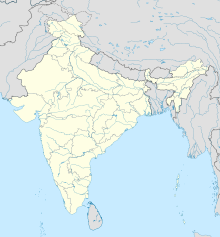|
Lodna Area
Lodna Area is one of the 12 operational areas of BCCL located in Dhanbad Sadar subdivision of Dhanbad district in the state of Jharkhand, India. HistoryThe Bhowra Area was earlier merged with Lodna Area.[1] Geography
3km 2miles
BCCL Bhojudih Washery W
River
Damodar
Eastern Jharia Area office A
Lodna Area office A
BCCL Patherdih washery W
BCCL Sudamdih washery W
SAIL Chasnala washery W
SAIL Chasnala colliery M
Amlabad colliery U
Sudamdih Shaft colliery U
Sudamdih Incline colliery U
Patherdih colliery M
Bhowrah South colliery M
Bhowrah North colliery M
BCCL Regional Hospital, Jealgora F
SAIL Jitpur colliery U
Tata Steel Jamadoba Group of Mines U
North Tisra South Tisra Expansion O
Bararee colliery U
Jeenagora colliery O
Joyrampur colliery U
Bagdigi colliery U
Jealgora colliery U
North Tisra South Tisra colliery O
North Tisra colliery U
Lodna colliery U Collieries in the Lodna and Eastern Jharia Areas of BCCL U: Underground colliery, O: Open Cast colliery, M: Mixed colliery, W: Washery, F: Facility, A: Administrative headquarters Owing to space constraints in the small map, the actual locations in a larger map may vary slightly LocationThe Lodna Area office is located at 23°43′12″N 86°24′38″E / 23.72011°N 86.41059°E. The Lodna Area is situated in the central area of Jharia coalfield and is 15 km south of Dhanbad Junction railway station. The Dhanbad-Sindri Road passes through the Area.[1] The map alongside shows some of the collieries in the Area. However, as the collieries do not have individual pages, there are no links in the full screen map. In the map placed further down, all places marked in the map are linked in the larger full screen map. Mining activity
Apart from the collieries of BCCL, there also are other collieries in the region:
Mining plan
5km 3miles
Damodar River
Baliapur CT
Suranga CT
Alagdiha CT
Moonidih R
BCCL Lodna Area
BCCL Eastern Jharia Area
BCCL Pootkee Balihari Area
Bardubhi CT
Sansikhara CT
Aralgoria CT
Sialgudri CT
Pondar Kanali CT
Chasnala N
Tisra N
Sudamdih O
Sindri N
Rohraband N
Putki N
Pathardih N
Lodna N
Kustai N
Kenduadih N
Jorapokhar N
Jeenagora N
Jealgora N
Jamadoba N
Chhotaputki N
Baliari N
Bhowrah N Cities, towns and locations in the southern portion of Dhanbad Sadar subdivision in Dhanbad district MC: Municipal Corporation, CT: Census Town, N: Neighbourhood, R: Rural/ Urban centre Owing to space constraints in the small map, the actual locations in a larger map may vary slightly An overview of the proposed mining activity plan in Cluster IX, a group of 9 mines in the Lodna Area, as of 2012, is as follows:[4] 1. Lodna colliery, with an underground mine, has a normative production capacity of 0.115 million tonnes per year and a peak production capacity of 0.150 million tonnes per year. It had an expected life of 30 years. 2. North Tisra colliery, with an underground mine, has a normative production capacity of 0.15 million tonnes per year and a peak production capacity of 0.195 million tonnes per year. It had an expected life of 30 years. 3. North Tisra-South Tisra colliery, with an open cast mine, has a normative production capacity of 1.65 million tonnes per year and a peak production capacity of 2.145 million tonnes per year. It had an expected life of 26 years. 4. Jealgora colliery is a closed mine. 5. Bagdigi colliery, with an underground mine, has a normative production capacity of 0.11 million tonnes per year and a peak production capacity of 0.143 million tonnes per year. It had an expected life of 30 years. 6. Joyrampur colliery, with an underground mine, has a normative production capacity of 0.153 million tonnes per year and a peak production capacity of 0.199 million tonnes per year. It had an expected life of 30 years. 7. Jeenagora colliery, with an open cast mine, has a normative production capacity of 0.7 million tonnes per year and a peak production capacity of 0.91 million tonnes per year. It had an expected life of 5 years. 8. Bararee colliery, with an underground mine, has a normative production capacity of 0.17 million tonnes per year and a peak production capacity of 0.221 million tonnes per year. It had an expected life of 30 years. 9. North Tisra-South Tisra expansion open cast mine was a proposed colliery (in 2012) with a normative production capacity of 6 million tonnes per year and a peak production capacity of 7.8 million tonnes per year. It had an expected life of 30 years. The production from NT-ST OCP, Jeenagora OCP and 6 No. incline of North Tisra UG colliery was planned to be closed/ merged/ dovetailed into the proposed opencast. References
|
||||||||||||||||||||||

